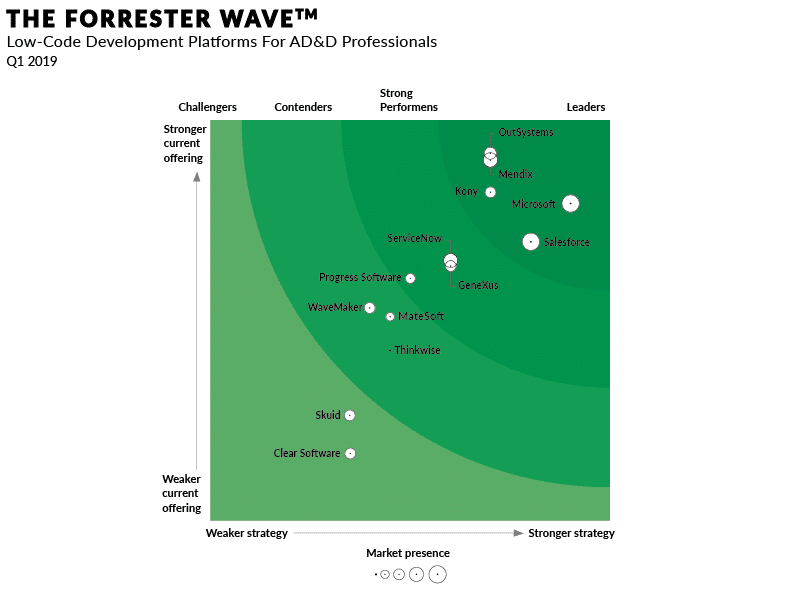Low-Code/No-Code Development Platforms
Low-code and no-code development let companies bring their dream of rapid app development to life. With low-code and no-code development platforms, app design and development becomes quicker and easier. It also lets IT departments relax and concentrate on their critical tasks, while everyday business users are now busy with app development tasks.
But finding the right low-code/no-code development platform isn’t easy. Since many low-code development tools serve lots of different purposes, you can easily get lost not knowing where to start and what to choose. Don’t panic. This article by pwrteams will help you sort things out with low-code/no-code development platforms.
The Advent of Low-code/no code software development
The software development market grows in a frenzy, responding to either demand or supply. But what if the demand created by digital everything outgrows proposition in particular business areas? Or what if there aren’t enough software programmers who are eager to satisfy the tiniest needs of business departments that might have a request today but not tomorrow? These are just some of the reasons why low-code and no-code development exist.
Low-code VS No-code: Don’t get confused!
The “low” and “no” notions are often treated as twins or siblings. In reality, they are rather distant relatives who see each other once a year for Christmas.
No-code platforms are designed for people who are not software developers. Having a particular business need, they can create apps by dragging and dropping application components or connecting them.
Low-code development, in contrast, will require some assistance of in-house developers. The developer’s responsibility might be to make minor changes to the back-end code to comply with security measures, add third-party components, if required, or include additional data sources. A research by Forrester estimates that the total market for low-code development platforms will grow to $15.5 billion by 2020.
The challenge of choosing low-code and no-code development platforms
The effortless spirit surrounding low-code/no-code development platforms is often deceptive. When it comes to selecting the necessary platform, there are three types of challenges. However, it’s not that easy to satisfy two different categories of users with opponent goals and a distinct set of skills. Next, think of the purpose or the business goal you want to achieve with this approach. Moreover, the objectives of a big enterprise and a small startup will vary, and development tools should take it into account. Finally, do you need to develop a web version or a mobile app? The answers will narrow down your search.
How do you decide on a low-code or a no-code development platform?
First of all, make sure you’ve weighed everything before deciding on a particular low-code/no-code development service. Here’s what you have to consider:
- Think of your pain points. Low-code/no-code development platforms tackle specific business tasks and solve real problems within an organization. Specify these problems and business needs strictly and define their priorities.
- Think of the users. While selecting low-code over no-code and vice versa, always keep in mind the users behind each solution. Ask yourself: who is going to develop the app? What set of skills do they have? How eager are they to learn something new?
- Keep tech specialists as a fallback strategy. Plan B has rescued many situations. So, in case of an emergency or some difficulties, have some experienced developers or tech professionals to help you out.
- Verify scalability. Make sure the platform is enterprise-grade and easily scalable. Moreover, it shouldn’t be something that you have to invest heavily in.
- Cross-platform functionality is vital. Make sure that the platform you’re selecting will let you develop apps with cross-platform functionality.

Low-code/no-code development platforms
From year to year, reputable market research companies like Forrester evaluate platforms, comparing them against various criteria and business goals. Take a look at this year’s leaders in platforms for application development and delivery (AD&D).

Source: Forrester
Here’s a breakdown of the data gathered by Forrester. It’s true that the leading vendors will offer the highest pricing models. However, smaller startups, instead, might offer reduced functionality at lower costs.
Top 10
- PowerApps
Platforms it supports: web-based, iOS, Android, Windows
Price: Two pricing plans are available. Plan 1 costs $7 per user per month and Plan 2 costs $40 per user per month. A free trial is available. - Salesforce Lightning Platform
Platforms it supports: web-based, Windows, Mac
Price: Starter plan: $25 per user per month; Plus plan: $150 per user per month. A free trial is available. - Mendix
Platforms it supports: web-based, Windows, Linux, Android, iPhone, Windows Phone
Price: Single App starts at $1,875 per user per month; Pro starts at $5,375 per user per month; Enterprise starts at $7,825 per user per month. The community version is free. - OutSystems
Platforms it supports: web-based, Windows, Mac, Linux, iPhone, Android
Price: Enterprise starts at $6,250 per user per month. Universal starts at $15,000 per user per month. A free plan is available. - Kony Quantum
Platforms it supports: cloud-based, iOS, Android, Windows
Price: Free plan covers only one application and a maximum of 25 users. Enterprise starts at $2,500 monthly - ServiceNow
Platforms it supports: web-based, Windows, Mac, Android, iOS
Price: provided upon request. - GeneXus
Platforms it supports: web-based, cloud-based, Android, BlackBerry, iOS, Windows 8 IBM, Linux, UNIX, Windows
Price: There are pricing plans for software development houses, enterprises, students and startups. Prices are provided upon request. - Progress Kinvey
Platforms it supports: mobile, web and chat-based apps
Price: It has two paid subscription options: the Business Edition, which starts at $4,995 per month and Enterprise Edition, which is custom priced. A free trial is available. - MatsSoft Mats Platform
Platforms it supports: web-based, iOS, Android
Price: starts at $30 per month per user. A free trial is available. - WaveMaker
Platforms it supports: web-based, mobile-based (iOS, Android, Windows Mobile, BlackBerry/RIM, etc.)
Price: the Professional pricing plan costs $249 per developer per month.
Summing up
Above all, low-code and no-code development are great options for organizations that either have no tech department or are too busy crafting software for their customers. But you do have to find the right platform that would help you build apps without coding (or with minimal coding). To do this, think of the pain points the app is going to cover, who’s going to build the app and will your app be scalable and cross-platform. With these answers in mind, look at the reports of reputable market research companies to make your decision or contact us to get the professional view. Good luck!

